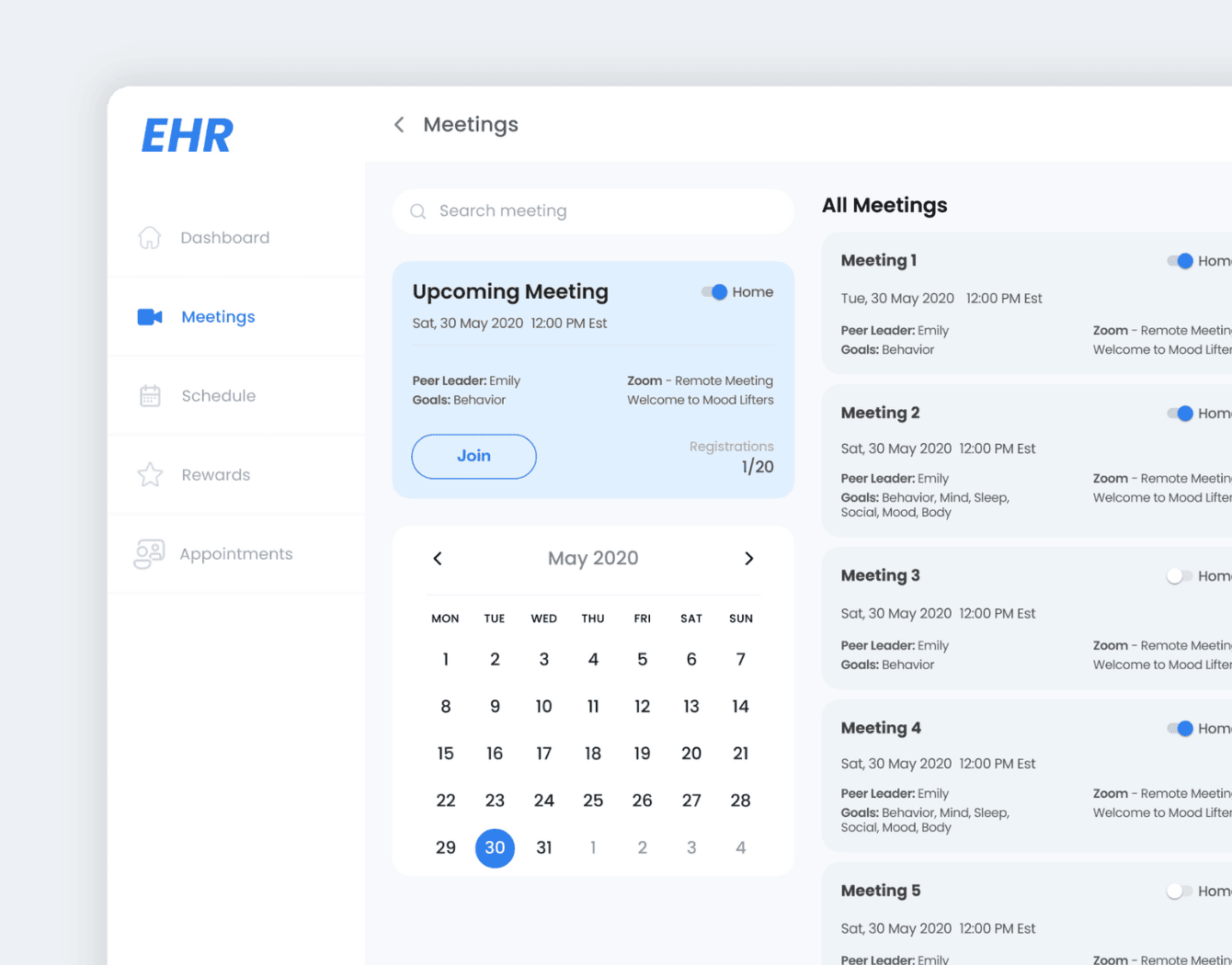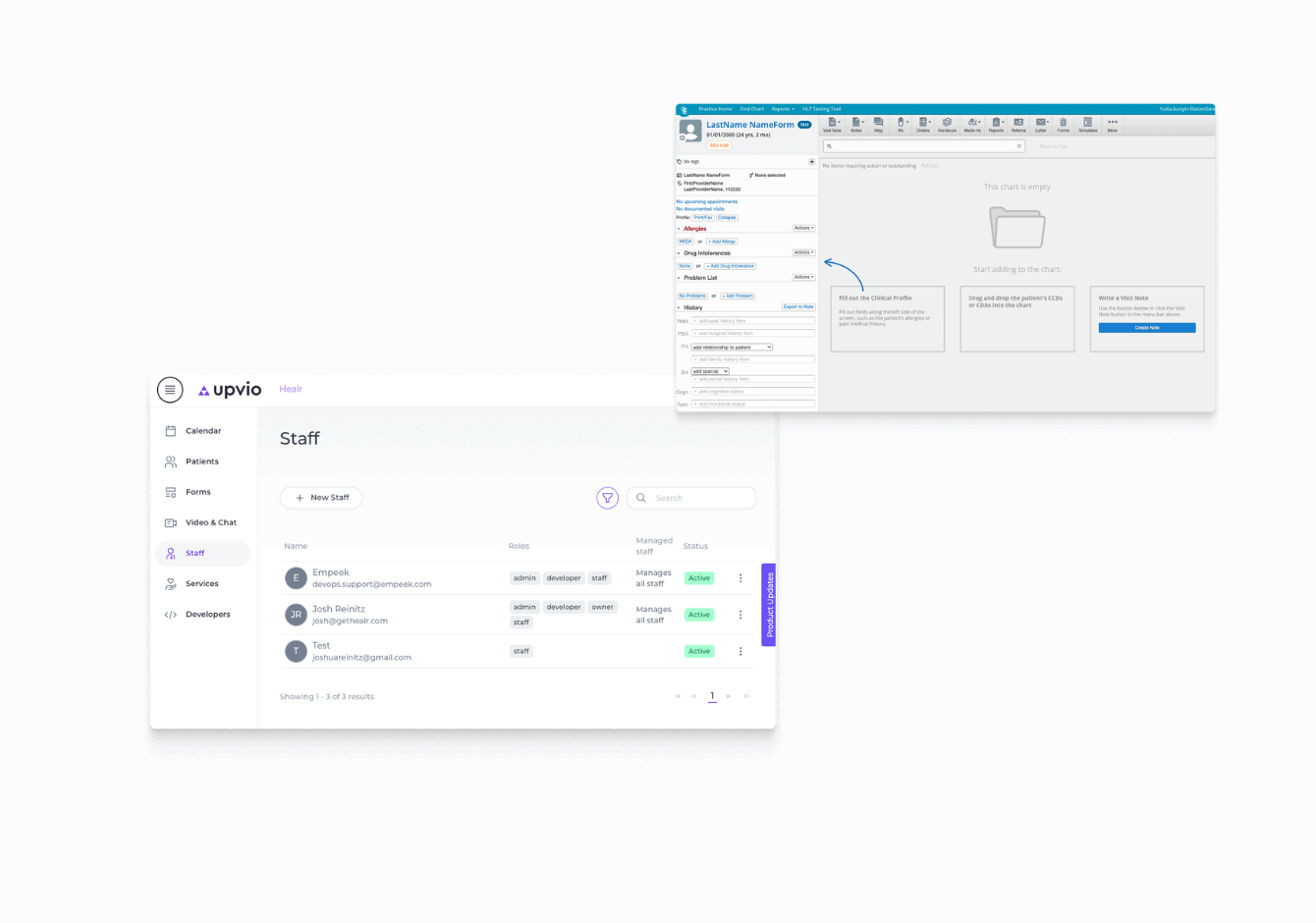
Patient Flow Management System
We develop custom patient flow management systems that help medical staff manage patients from pre-arrival, arrival and treatment, to post-treatment within a single platform.
Contact UsWe develop custom patient flow management systems that help medical staff manage patients from pre-arrival, arrival and treatment, to post-treatment within a single platform.
Contact UsPatient journey management software tackles the complexities of healthcare navigation. It ensures patients move efficiently through each stage of care, from scheduling appointments to receiving treatment and leaving the facility. This translates to shorter wait times, improved operational efficiency, and ultimately, a smoother experience for everyone involved.
While off-the-shelf software offers basic functionality, it often lacks the ability to address the specific needs of your healthcare facility. Custom development allows for a tailored solution, and results in a product that is user-friendly and directly impacts overall delivery of healthcare services.
From improved use of resources to reduction in lengths of stay, tailor-made patient flow solutions contribute to a more efficient, cost-effective, and patient-centric healthcare environment.
A bespoke patients flow management system is designed specifically for your healthcare facility, meaning it aligns perfectly with how you operate. It ensures that every step of patient care is optimized to meet your unique care workflow.
All the tasks involved in patient care, from patients´ arrival at the facility to their treatment and follow-up care, are managed within a single system. This makes it easier for the medical staff to access and update information, which results in smoother healthcare process flow, error reduction and employee burnout.
Improved patient flow through optimized scheduling and reduced wait times leads to shorter lengths of stay. This translates to increased patient throughput and better use of resources as well as allows patients to recover in the comfort of their own homes sooner.
Business gains real-time visibility into resource availability and optimizes allocation of staff, equipment, and rooms to ensure they are used efficiently. It minimizes wasted time and resources, and allows it to serve more patients effectively.
A custom patient flow management system is integrated with existing healthcare IT infrastructure, such as electronic health records (EHR) systems and billing software without causing a disruption to your current workflows.
Custom software is designed to be scalable, so you can easily add new features and functionalities as your practice grows and your needs evolve.
By automating repetitive tasks and providing easy access to information, this system reduces the burden on your staff. With less stress and more support, they can focus on what they do best—providing excellent care to your patients.
Improve Patient Satisfaction Scores With Our Patient Flow Software
Consult with ExpertExploring the development of a patient tracking system reveals our dedication to improving healthcare and patient satisfaction. Through careful planning, design, and teamwork, we aim to create a solution that makes a difference.
The first step for our development team is to really understand your needs. We do this by talking directly with the people who will be using the system, like doctors, nurses, and hospital administrators. We’ll ask questions to figure out exactly what your hospital needs from a patient flow management system. This might include things like tracking patient information, scheduling appointments easily, and generating reports to see how things are running.
Once we have a clear idea of what you need, our team gets to work on building the system’s blueprint. This blueprint includes things like how the data will be stored, how the system will look for the users, and how it will talk to other programs you might already use in the hospital. All along the way, we keep in mind three things: making sure the system can grow as your needs do, keeping everything safe and secure, and designing it so it’s easy for everyone to use.
With the blueprint in hand, our developers get to work on bringing the system to life. They’ll build the main features you need to keep track of your patients, like registering new patients, managing appointments, seeing where everyone is at in the process, and running reports to see how things are going.
Once the core system is built, we’ll connect it to the other programs you already use in the hospital, like the system for patient medical records (EHR) and billing. Then, we put everything through its paces with thorough testing to make sure all the pieces work together smoothly and do exactly what we set out to achieve.
Following system development and testing, we facilitate the deployment of the patient tracking system. Additionally, we provide ongoing support services to address any operational inquiries or optimize system usage for enhanced efficiency.
Discover Our Custom Patient Tracking System For Your Specific Healthcare Practices
Reach out nowPROJECT SUCCESS
Core functionality include:
Explore the Project
PROJECT SUCCESS
We’ve created web and mobile applications to help doctors and patients optimize the treatment process.
Explore the Project
This project aims to integrate two healthcare systems, Upvio (Practice Management) and Elation (Electronic Health Record), to synchronize appointments, payment management, and enable communication between users.
Coming soon








Discover The Possibilities Of Custom Patient Flow Manage Software For Your Healthcare Institution
Book a consultationInvesting in custom patient flow technologies represents a strategic decision for healthcare organizations. This means that getting software for patient management requires careful thought about factors like how much it will cost, how long it will take to develop, and what benefits it will bring in the long run.
There are ongoing costs to consider after the software is up and running, like fees for storing the data (cloud fees) and maintenance. The strength and security of this storage also impacts the price. While a basic setup might be cheaper upfront, but a more robust system with stronger security features might be a better long-term investment.
The brains behind the software can make a big difference in price. Sure, a team of coding whizzes or a larger crew might cost more, but they’re like having healthcare IT superheroes on your side. They can make sure the software follows all the rules and plays nicely with your other computer systems, saving you headaches down the road.
Getting the new patient flow software to work with all your other computer systems, like electronic records or billing, can add time and money to the project. The more systems you have to connect, the more complex it gets, and the longer it takes.
The toolbox the developers use matters. Some high-powered tech might have a steeper price tag or require a specialist to operate. They also have to think about how the system can handle future growth (think adding more users or features – that’s scalability), keeping it safe from cyberattacks (security), and ensuring it meets all the healthcare regulations (compliance). These choices all influence the initial investment and ongoing costs.
The more features you need, like appointment scheduling, patients tracking, and custom reports, the more the system will cost. This is because more complex features take more time and effort to develop. On top of that, if you want the system to fit exactly how your healthcare facility works, that can also add to the cost. Customizing things usually requires more work from the developers.
This is the perfect model for projects with evolving requirements or uncertain scopes. Clients are billed based on the hours worked by our team and any materials or resources used. It offers flexibility, allowing for adjustments and changes as needed throughout the development process.
Under this model, clients are assigned a dedicated account manager who serves as their main point of contact throughout the project. The account manager manages expectations, and ensures the project progresses according to plan. This approach fosters strong client-provider relationships and enables effective project management.
It is suitable for projects with well-defined requirements and clear scopes of work. The project scope, timeline, and cost are established from the beginning, and clients pay a fixed price for the entire project. The pricing is based on agreed-upon requirements, deliverables, and milestones.
Patient flow refers to the journey patients undertake within a healthcare facility. It encompasses medical care, resources, and internal systems.
A Patient Management System (PMS) is a software solution tailored to optimize and consolidate the handling of patient-related information and tasks within the healthcare setting. It equips healthcare staff and administrators with efficient tools to oversee patient records, appointments, and all facets of care provision.
Patient throughput is the progression of patients from arrival to discharge within a healthcare facility. It encompasses the care, resources, and decision-making processes necessary for guiding patients through their healthcare journey.
Here are a few tips on how to improve patient flow management in your healthcare facility:
Some essential features of unique patient workflow software are the following, among others:
There are several steps involved to ensure patient workflow software’s compatibility with your current infrastructure:
The ongoing maintenance and support plan for patient workflow software includes the following steps:
Here are some security measures you can implement to protect patient data, among others:
Tailored patient flow software enhances patient satisfaction through process optimization, improved communication, personalized healthcare experiences, and enabling patients to navigate their health journey on their own.
Yes. By streamlining patient scheduling, optimizing resource allocation, and automating administrative tasks, it enhances operational efficiency while minimizing manual labor and associated costs. Integration with billing systems and data-driven decision-making contributes to streamlined revenue cycle management and strategic cost reduction initiatives.
The success of the patient flow software implementation can be measured through various KPIs, such as: